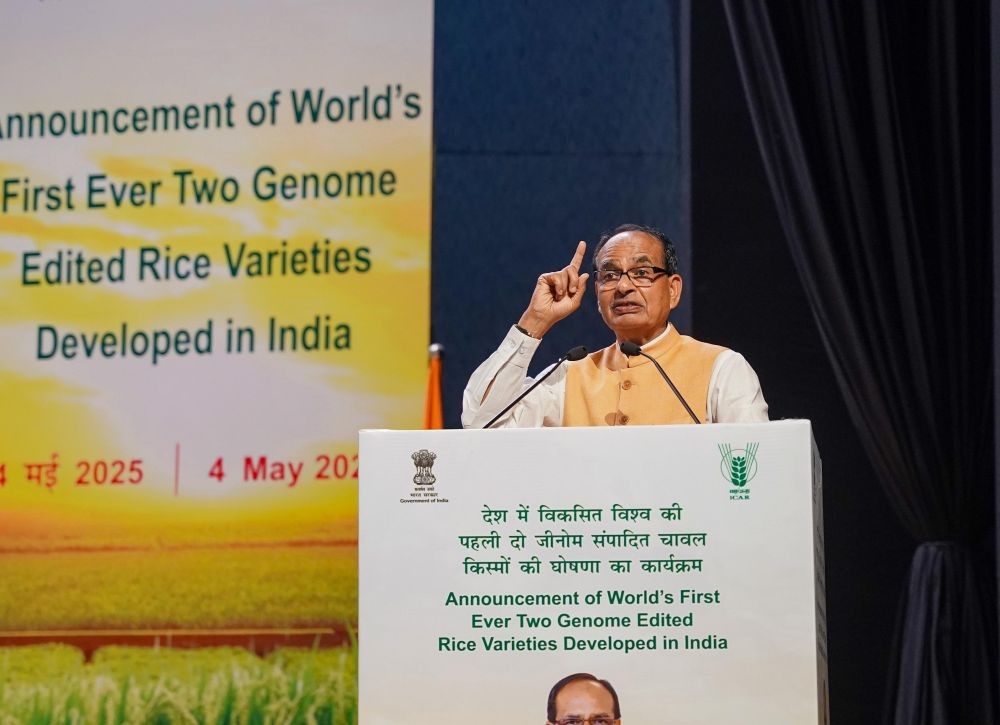
The Union Agriculture Minister, Shri Shivraj Singh Chouhan, informed the nation through his announcement on May 4, 2025, that India had created its first set of CRISPR-Cas technology-based genome-edited rice varieties DRR Rice 100 (Kamla) and Pusa DST Rice- 1. These varieties developed by ICAR institutions present a significant advance in sustainable farming practices that resist climate changes. The research developed rice varieties that bring higher yield results, lower greenhouse gas emissions, and enhanced ability to thrive in dry and salty conditions. This scientific achievement received recognition during a Delhi-based NASC Complex celebration which welcomed important agricultural scientists as well as policymakers.
Summary:
-
Through CRISPR-Cas technology India introduced two genome-edited rice varieties making the country the very first worldwide to achieve this milestone without incorporating foreign DNA.
-
Through their introduction two new rice varieties enhance yield options by 30.4% while also enabling water savings of 7,500 million cubic meters and lowering greenhouse gas emissions by 20%.
Key Points:
-
Varieties Released: DRR Rice 100 (Kamla) and Pusa DST Rice 1.
-
The biosafety rules of India classify CRISPR-Cas genome editing technology as SDN-1 and SDN-2 which enables its use.
-
Benefits:
-
19% higher yield (average).
-
20% reduction in GHG emissions.
-
7,500 MCM water saved.
-
Tolerance to drought, salinity, and climate stress.
-
The plan achieves early maturity while providing strong stalk support for lodging prevention.
-
-
Geographical Suitability: Targeted for 13 major rice-growing states across agro-climatic zones.
-
Policy Push: The Indian government has dedicated ₹500 crore toward genome editing in its latest budget that was released in 2023–24.
-
"Minus 5, Plus 10" Formula: Reducing rice cultivation in 5 million hectares combined with increased production of 10 million tons results from the "Minus 5, Plus 10" Formula.
Impact of Genome-Edited Rice in India
Agricultural Impact:
-
The productivity level improves by 30.4% which leads to increased rice output while maintaining the same farming land size.
-
The new plants will demonstrate greater ability to withstand drought conditions and salinity damage as well as endure climate-related stress.
-
DRR Rice 100 enables farmers to plant and harvest two rice crops per year because it shortens the growth period by twenty days.
-
Genome-edited rice reduces farmers' dependence on water supplies and fertilizers, which leads to more economically sustainable agriculture.
Environmental Impact:
-
Water Conservation: Saves 7,500 million cubic meters of irrigation water—critical for water-stressed states.
-
The 20% decrease in methane emissions helps India fulfill its goals outlined in the Paris Climate Accord National Determined Contributions.
-
The reduction of waterlogging together with salinity stress leads to better long-term preservation of soil quality.
Socio-Economic Impact:
-
Farmers receive better earnings because of higher harvest outcomes and increased resistance which decreases financial risk while making incomes more predictable.
-
By promoting youth engagement the program facilitates younger generations to implement modern agri-tech technologies and scientific practices.
-
The improved competitive power driven by this initiative enables India to reach ₹48,000 crore annual Basmati rice export value.
Importance of the Initiative
-
Scientific Leadership:
-
India leads the world as the first nation to create genome-edited rice which does not include foreign DNA materials.
-
India demonstrates its ability to work with advanced biotechnological technologies through its CRISPR-Cas practices.
-
-
Food Security & Self-Reliance:
-
Supports ‘Aatmanirbhar Bharat’ in agri-science.
-
The initiative enables sustainable feeding of an expanding populace.
-
-
Second Green Revolution:
-
The initiative maintains the success of Green Revolution 1 while adding sustainability along with climate adaptation features.
-
-
Efficient Land Use:
-
The "Minus 5, Plus 10" strategy seeks to lower water-intensive rice cultivation areas and introduce oilseed or pulse farming areas.
-
-
Biosafety & Public Acceptance:
-
The treatment and regulatory approval process for genome-edited crops including SDN-1 and SDN-2 differs from GMOs because of which there is better public acceptance and safer approval systems.
-
Challenges:
-
Many of the small and marginal farmers cannot obtain information and resources.
-
The public continues to confuse genome-edited organisms with genetically modified organisms even though SDN-1/2 received regulatory clearance.
-
These new crop varieties face difficulties in attaining market immunity framework and procurement policies from the government.
-
Open-access seed availability needs special attention since seeds were created through public research.
Way Forward
-
The extension services with strengthened Krishi Vigyan Kendras should reach out to farmers for education about new practices.
-
Policy Integration: Align crop insurance, MSP, and procurement policies with new genome-edited varieties.
-
Genome editing should move forward with pace into oilseed development as well as pulse development and millet transformation to achieve increased benefits.
-
Public-private partnerships should advance innovation through relationships with IP rights protected at a favorable level for farmers.
Conclusion:
The market entry of genome-edited rice makes India a worldwide leader in agricultural biotechnology while creating a new era for Indian farming. Indian goals related to food security and export competitiveness and sustainable farming practice find alignment with these recent advances. These varieties provide solid progress toward the planned second Green Revolution that connects productivity to environmental conservation.



 Supreme Court Stresses Protection for Honest Officers Under PCA
Supreme Court Stresses Protection for Honest Officers Under PCA PM Internship Scheme: Female Participation Rises to 41% from 31%
PM Internship Scheme: Female Participation Rises to 41% from 31% Pariksha Pe Charcha Sets Guinness World Record by highest number of registrations
Pariksha Pe Charcha Sets Guinness World Record by highest number of registrations Pingali Venkayya: The Man Behind India’s Tricolour
Pingali Venkayya: The Man Behind India’s Tricolour Operation Muskaan-XI: A Lifeline for India’s Lost and Exploited Children
Operation Muskaan-XI: A Lifeline for India’s Lost and Exploited Children 71st National Film Awards 2025: Celebrating Diversity, Craft, and Cultural Narratives in Indian Cine
71st National Film Awards 2025: Celebrating Diversity, Craft, and Cultural Narratives in Indian Cine IPPB’s Aadhaar-Based Face Authentication and the Future of Digital Banking in India
IPPB’s Aadhaar-Based Face Authentication and the Future of Digital Banking in India Lt.-Gen. Pushpendra Singh Appointed as Vice-Chief of Army Staff
Lt.-Gen. Pushpendra Singh Appointed as Vice-Chief of Army Staff PM to Inaugurate Science Meet on Swaminathan’s Birth Centenary
PM to Inaugurate Science Meet on Swaminathan’s Birth Centenary Mera Gaon Meri Dharohar (MGMD): Cultural Mapping for Rural Identity and Development
Mera Gaon Meri Dharohar (MGMD): Cultural Mapping for Rural Identity and Development






